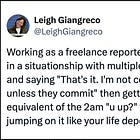What editors are *really* looking for
It's not fancy bylines, it's communication. (And no, we don’t care if you went to journalism school.)
Hello friends, and welcome to week two of Intro to Freelancing Month at FWT!
Today we’re going to pull back the curtain a bit on building lasting, sustainable, productive, and just great relationships with editors.
This was the idea behind a conversation I hosted recently in which I and a few other editors who work with freelancers — Julie Gerstein and Laura Norkin — talked about the things editors look for in freelancers, what we want in that working relationship, how freelancers can become regulars, and what editors aren’t really interested in. (Spoiler: We care about fancy degrees and fancy bylines far, far less than you might think.)
SO. What are editors really looking for, and how can freelancers stand out from the crowd?
Let’s get into it.
Does your background, your bylines, or your ‘pedigree’ matter?
Not nearly as much as you’d think!
Editors want good stories, no matter where they come from. If you’re a student, new to the industry, or getting back in after some time away, just bring good ideas — that’s what editors care about. Does it help if you’ve had a story in The Boston Globe or Esquire? Sure, of course. But that’s never going to be the deciding factor — or sometimes even a significant factor — when an editor is considering your idea.
Much more important factors are whether your story is important to that publication’s (and, even further, that section’s) audience; whether it adds to a conversation, topic, idea, or cultural discourse; how original and unique it is; and if you’re the right person to tell this particular story.
When editors take on stories from less experienced journalists, students, or people who don’t exactly specialize in the topic or story type they’re pitching, we do so with the understanding that this idea might take a little more effort, energy, and time than stories from people who have been doing this for 20 years. And that’s okay! One of the joys of being an editor is seeing our writers grow and develop, and we want to work on stories with you that push us both to become better journalists. Even if you’ve never written a story around X topic, pitch it anyway and swing for the fences. Why not see if The Washington Post is interested! The worst thing that can happen is you’ll get a rejection, and then you can just move on to the next outlet. If an editor is going to reject an idea, let them do it; don’t reject yourself before you even have a shot.
(And, just to put this one to bed: No, we don’t care if you went to journalism school.)
What editors want in a pitch beyond just the basics
I’ve written about and talked often about a pitch format that I think works for most stories, but that’s just the basic outline of what you need in a pitch. As far as the actual content goes, we really want you to stretch a little bit and, well, show off.
A pitch is your first opportunity — and, often, the most important — to demonstrate who you are as a writer. What’s your style? Your voice? Your approach to telling a story or describing a scene or character? Do you know how to hook and engage an audience? Can you write with color, vividness, and lucidity? Show us! It’s perfectly fine to talk about your bio, describe the story, then talk about the contour of its structure, focus, and overall purpose. But you can capture all of that and so much more if you take a big chance and really write through the idea and show us your chops.
Just to reiterate what I wrote in that pitch format guide,
Got great characters? Introduce them right away. Big drama or tension? Put that directly into the opening of the pitch. Illuminating data that tells a story? Give it to the editor right off the bat. This first section is where you put the absolute best, juiciest, and most compelling aspects of your story, written out as if this section could fit right into a draft of the story. [...] You want to get the editor excited about and invested in your story, and the best way to do that is to put them right in the middle of it. Give away the goods and draw your reader in immediately.
In the conversation with the other editors, Laura added: Understand “the goal of the publication or of the editor, and acknowledge in what way your story is going to help them achieve that goal.” This is where getting really familiar with the publication — and the editor — comes into play in a huge way. Editors can tell within a few sentences if a freelancer has tailored a pitch to the publication or editor, and that effort is always well worth it. Doing that will make your pitches stronger, and your success rate will increase.
I offer one-on-one coaching! Need help developing an idea or sharpening one you already have? Want a seasoned eye on a pitch you’re kicking around? Interested in talking about careers and building your freelance business? Maybe just want an edit on a story draft? I’ve got you covered! Click here to book a one-on-one coaching session to talk about pitches, story ideas and development, editing, careers, or anything else you might need help with!
‘Problems’ with a story aren’t really problems as long as you talk about them; then they’re conversations
Communication is soooo important, y’all. “Problems” only become actual problems when you don’t bring them up, or wait until you file to mention that things didn’t work out as you both had planned. Stories fall apart! Sources disappear! The reporting can lead you in a completely different direction than you expected! None of those is necessarily bad. They’re just part of the process, and they’re inevitable.
If you realize your story is morphing into something you didn’t plan for, just shoot your editor an email and let them know so you can course-correct and figure out where to go from there. Editors expect it, it’s not a reflection of your abilities, and a lot of the time it can turn into a real benefit for the story. Of course we want the story to follow the reporting, and not the other way around; we’re here to help you figure that out. We’re all on the same team working toward the same goal: making this story the best possible version of itself it can be.
Having ‘extra’ stuff for your story is cool — just know the right way to give it to your editor
End up running over your word count for your commissioned story? No worries, we’ll figure it out.
First, if you truly do need the extra space to tell this story, tell the editor as soon as you realize it. (Again, it’s not a problem if you mention it.) The last thing you want to do here is file 2,400 words when you both agreed on 1,700, so just mention it.
The more nuanced variation of this is when you have great stuff that doesn’t quite fit with the first draft of the story but that could still have a place. This is a good position to be in! You’ve done the requisite culling of your reporting, and you’re including a tad extra outside of the draft itself just in case. Often your instinct will be on the money if you think that extra stuff doesn’t totally work — right now. But that doesn’t mean it doesn’t have a place. If you think it may eventually fit, include it somewhere in the draft, just not directly in the story.
Laura talked about one instance in which a freelancer filed right at word count, but had this one anecdote they included as an “in case you want it” addendum. Sure enough, Laura wanted it.
To put it bluntly: The freelancers we love actually give a shit
That pretty much sums it up. Care about your story, care about the process, and care about making your story the best it can be. Your editor does, too.
Oh, a few other things …
• Get a pitch commissioned recently? I want to see it! I’d love to feature you and your #pitchesthatsold in an upcoming series examining great pitches that resulted in stories. Let’s see ’em!
• Got a question about freelancing or the wider world of journalism? Let’s hear it, and I may feature it in a future Q&A post! Drop your questions, comments, and thoughts about freelancing and journalism in general in a comment below, or email me at tim@freelancingwithtim.com.
• More from Intro to Freelancing Month:








